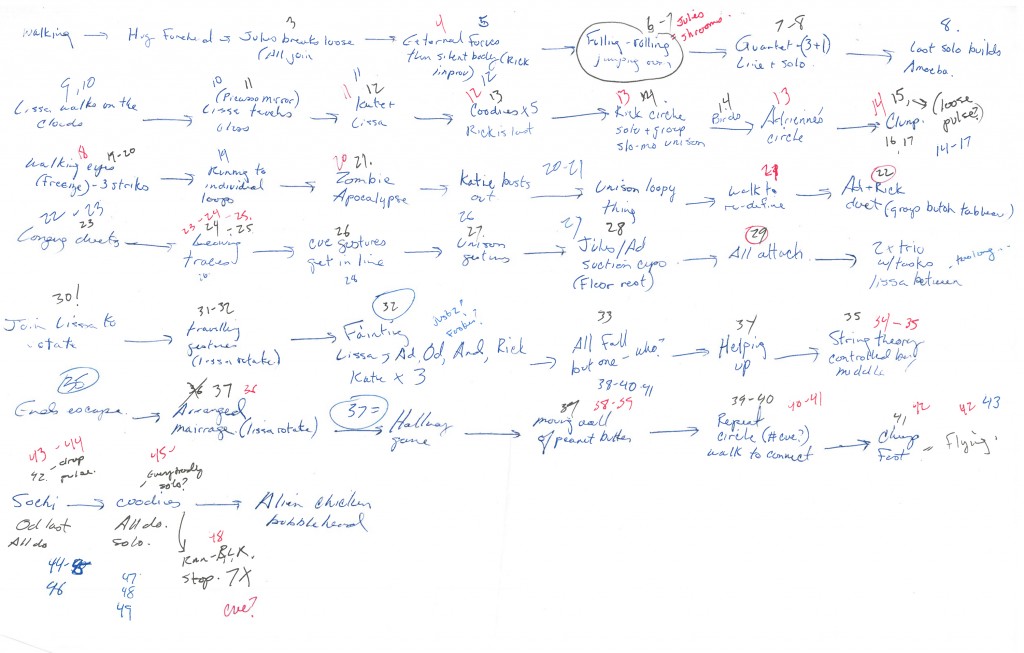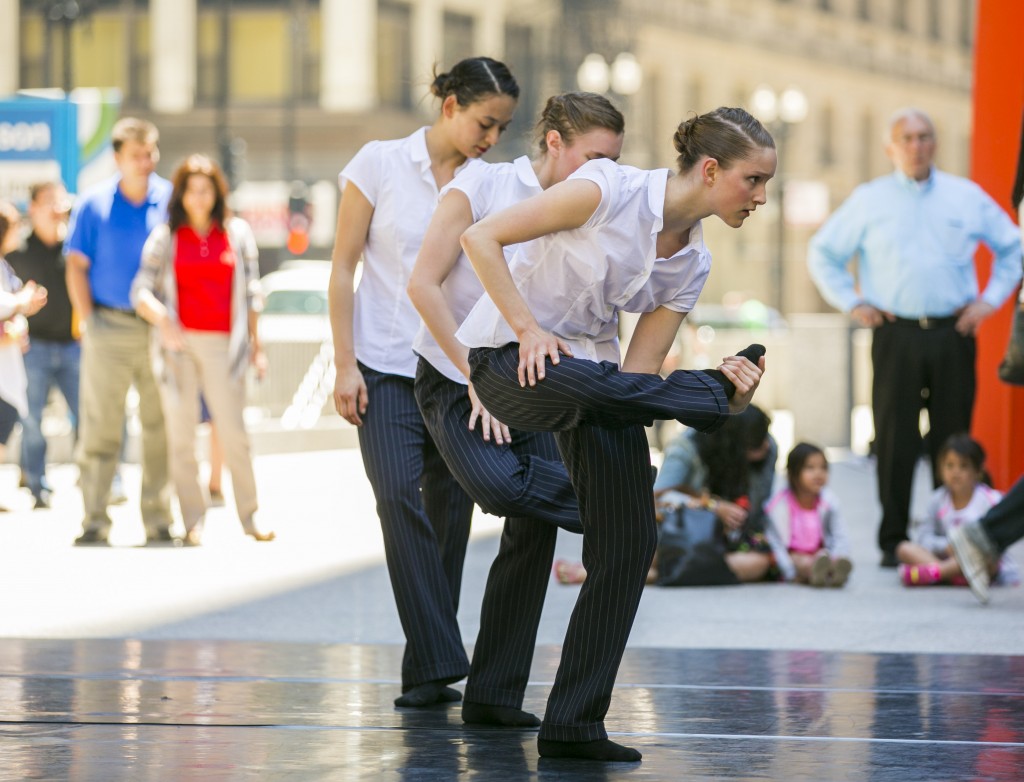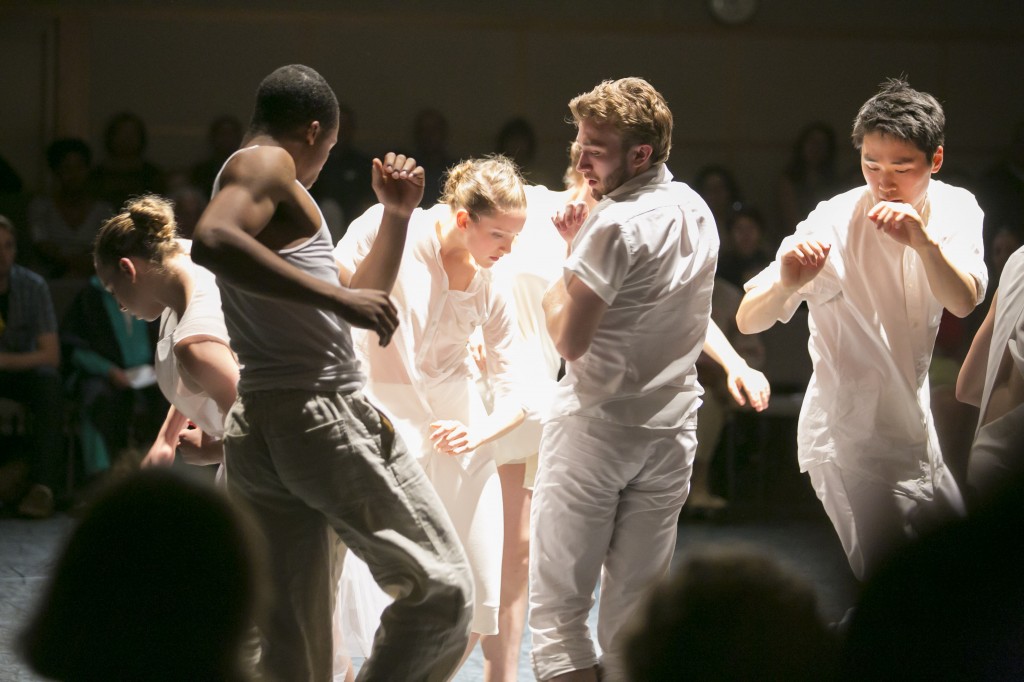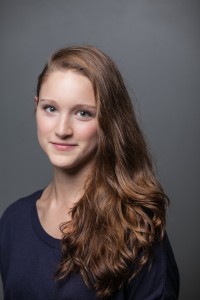
by Andrea Thompson
On Friday, June 6, I had the unique pleasure of performing a work’s world premiere and closing show within a nine-hour span. These were vastly different experiences — and that was the point.
For the past two months, my fellow Hubbard Street 2 dancers and I had been knee-deep in creation, collaborating with the Citizen Musician Fellows of the Civic Orchestra of Chicago. The focus was “In C,” a piece by composer Terry Riley that celebrates its 50th anniversary this year. It’s an unusual work to learn, requiring both its sheet music and a set of instructions for playing — and I mean “play” quite literally. Its structure is improvisatory in nature: Each musician is allowed to play the 53 musical phrases or “cells” of “In C” as many times as he or she pleases, dropping out and reentering the score at will. Riley’s instructions contain goals and guidelines, but outside of these each musician has freedom to decide in the moment what and when to play.
In the spirit of game-playing, listening, and the ephemeral nature of performance, we created — with the help of choreographer and Hubbard Street 2 director Terence Marling — our own approach to this ever-changing music. From early on, we knew we would perform an outdoor show to a recording of “In C” prior to an evening show accompanied live by the Citizen Musician Fellows.
In other words: One show would have a predetermined length, while the other could last anywhere from 30 to 90 minutes. Gulp.
We embarked on our choreographic journey by studying the cells, picking out landmarks we could identify regardless of how the score was interpreted. Cells of whole notes became our best, most recognizable friends. After familiarizing ourselves with the score, we had to figure out what the nature of our choreographic content would be. Games and improvisation seemed a natural fit given the structure of this music, so we set to work brainstorming new and favorite improv tasks, sharing visual images we wanted to achieve, and developing movement phrases inspired by the music.

Sequencing all that material was like putting a puzzle together. Certain ideas fell naturally in line with specific cells and became markers — assuming we’d be able to hear them in live performance — and then it was a matter of filling in the blanks with tasks that linked together logically. Like the musicians, we could stretch ideas out longer to challenge each other, or speed through them when it felt right. We developed a long string of cues and signals to indicate to each other when it was time to progress. We ended up with around 43 tasks, which spanned Riley’s 53 cells as a kind of roadmap. Our director Terry used a giant chronometer to denote each change of cell he heard in the music, so we would always know approximately where we were.
Of course, with our piece tied to spontaneity, every time we practiced our structure we landed somewhat differently on the recorded music. Terry rehearsed us to several different recordings of the piece in the week leading up to our shows, so that we wouldn’t be thrown off by unpredictable variations in the live music. And although we rehearsed a few times at Symphony Center’s Buntrock Hall with the musicians as well as every day in our West Loop studios, taking our piece outside meant encountering a whole new set of elements we could do nothing to prepare for indoors.
Our debut of “In C” kicked off the inaugural Living Loop Festival (produced by Chicago Loop Alliance and High Concept Laboratories). It was a gorgeous morning downtown when we arrived, with blue skies and warm temperatures. Our stage was in the shade at first, but by noon the sun was beaming down, warming our bodies and our marley as we adjusted to all the sights and sounds around Federal Plaza. Some people sat with their lunches just a few feet away from us, while others stayed further back and watched from a distance. Many stopped to catch just a few minutes of the piece; I even saw people across the street stopping to take in the scene.

All the outdoor elements lent themselves beautifully to the nature of the music and the choreographic structure we created to it. “In C” is about paying attention to your surroundings, and deciding to either counter them or let them inform you. Each spectator of our performance became a part of “In C” as they strolled by. The dancers tuned into each other, the music, the clock — and simultaneously took cues from passersby, the Alexander Calder sculpture sharing our plaza, buildings, and the perfectly blue sky above. All told, the performance was an exhilarating experience I won’t soon forget.
The evening performance was an equally memorable, though entirely different occasion. Buntrock Hall was set with a marley in the center of the space, while audience seating and musicians surrounded it on all sides. The piece began with a xylophone — the only constant element involved — setting the tempo, after which the musicians walked to their places and one by one, began playing the first cell. A few seconds later we followed to the edges of the space to enter one at a time as well.

Musician and dancer alike shared a palpable sense of anticipation. Everyone was open to informing and being informed by what we heard and saw — the backbone and the beauty of our collaboration — and I could sense that cooperative atmosphere as soon as I entered the room. Though we’d rehearsed together before, I was never more cognizant of the musicians’ eyes than during the show. In performance I was acutely aware that how I danced could have an impact on the upright bass, or the trumpet, or the viola — which could in turn affect how other musicians made their sounds. The unpredictable nature of “In C” became even more exciting knowing that I was part dancer, part listener and part co-conductor. Performing the piece with brilliant, enthusiastic live musicians brought it to life in a way completely different from performing outside earlier that day, yet equally fascinating.
It’s hard to believe the project we spent nearly two months on is now over, but the experience has certainly impacted me for the long term. Every member of HS2 contributed to the creation of our structure in a significant way, and I think we all came to realize the value of “just throwing ideas out there.” As a group, we tried every single proposal and held each other to refining what was unclear. We tried to create a work true to Terry Riley’s musical guidelines and appropriate to the playful, unpredictable nature of his piece. I think we not only succeeded in that, but also succeeded in opening ourselves up to new possibilities of how to choreograph, how to work together and how to collaborate with artists of other genres. Our “In C” may be over, but it has left an eternal eighth note–playing xylophone in my head and with it, an eagerness to enter the next cell.
Andrea Thompson enters her second year with Hubbard Street 2 at the start of the company’s 2014–15 season. During Hubbard Street’s satellite Summer Intensive Program at the University of Iowa, Thompson will teach ballet technique and HS2 repertoire to pre-professional dancers ages 14–17 from across the country. For a complete HS2 touring schedule, artist profiles and more, visit hubbardstreetdance.com.
________________________________
 Contributor Andrea Thompson (Maplewood, NJ) trained at the New Jersey School of Ballet, American Ballet Theatre’s Jacqueline Kennedy Onassis School and the Ailey School in New York City. Thompson has also studied at the Juilliard School, Northwest Professional Dance Project, Springboard Danse Montréal, Nederlands Dans Theater and Batsheva Dance Company, which brought opportunities to perform choreography by Gregory Dolbashian, William Forsythe, Natalia Horecna, Jessica Lang, Marina Mascarell, Idan Sharabi, Robyn Mineko Williams, Paul Lightfoot and Sol León. At the San Francisco Conservatory of Dance, under the direction of Summer Lee Rhatigan, she trained with and performed works by Christian Burns, Alex Ketley, Thomas McManus, Robert Moses, Ohad Naharin, Alessio Silvestrin and Bobbi Jene Smith. Thompson joined Hubbard Street 2 in August 2013, following work in San Francisco and New York with Zhukov Dance Theatre, Chang Yong Sung, LoudHoundMovement, Backwoods Dance Project and the Foundry.
Contributor Andrea Thompson (Maplewood, NJ) trained at the New Jersey School of Ballet, American Ballet Theatre’s Jacqueline Kennedy Onassis School and the Ailey School in New York City. Thompson has also studied at the Juilliard School, Northwest Professional Dance Project, Springboard Danse Montréal, Nederlands Dans Theater and Batsheva Dance Company, which brought opportunities to perform choreography by Gregory Dolbashian, William Forsythe, Natalia Horecna, Jessica Lang, Marina Mascarell, Idan Sharabi, Robyn Mineko Williams, Paul Lightfoot and Sol León. At the San Francisco Conservatory of Dance, under the direction of Summer Lee Rhatigan, she trained with and performed works by Christian Burns, Alex Ketley, Thomas McManus, Robert Moses, Ohad Naharin, Alessio Silvestrin and Bobbi Jene Smith. Thompson joined Hubbard Street 2 in August 2013, following work in San Francisco and New York with Zhukov Dance Theatre, Chang Yong Sung, LoudHoundMovement, Backwoods Dance Project and the Foundry.




